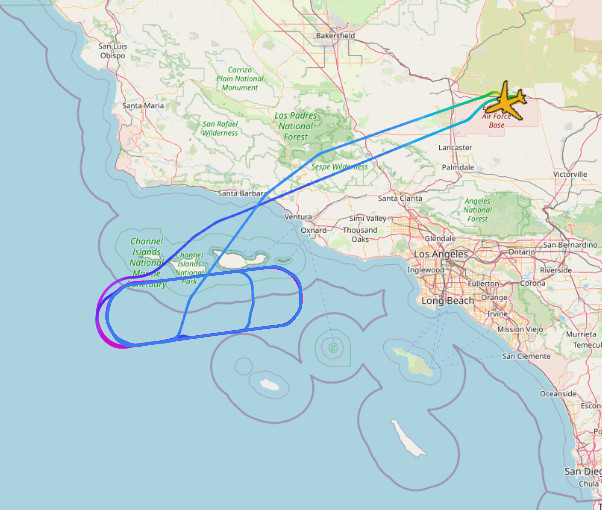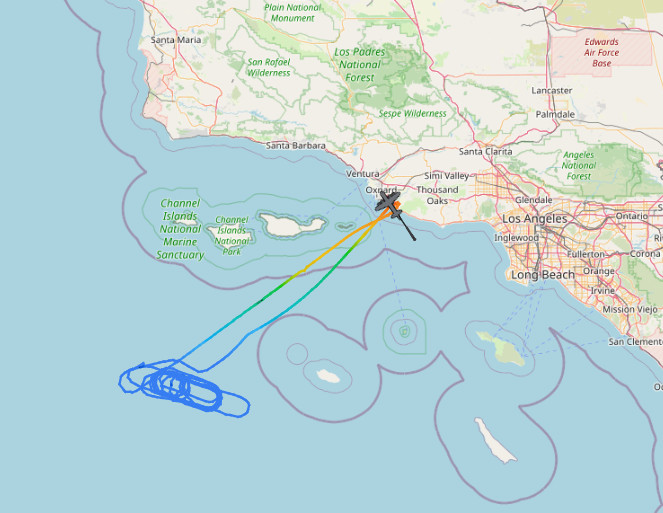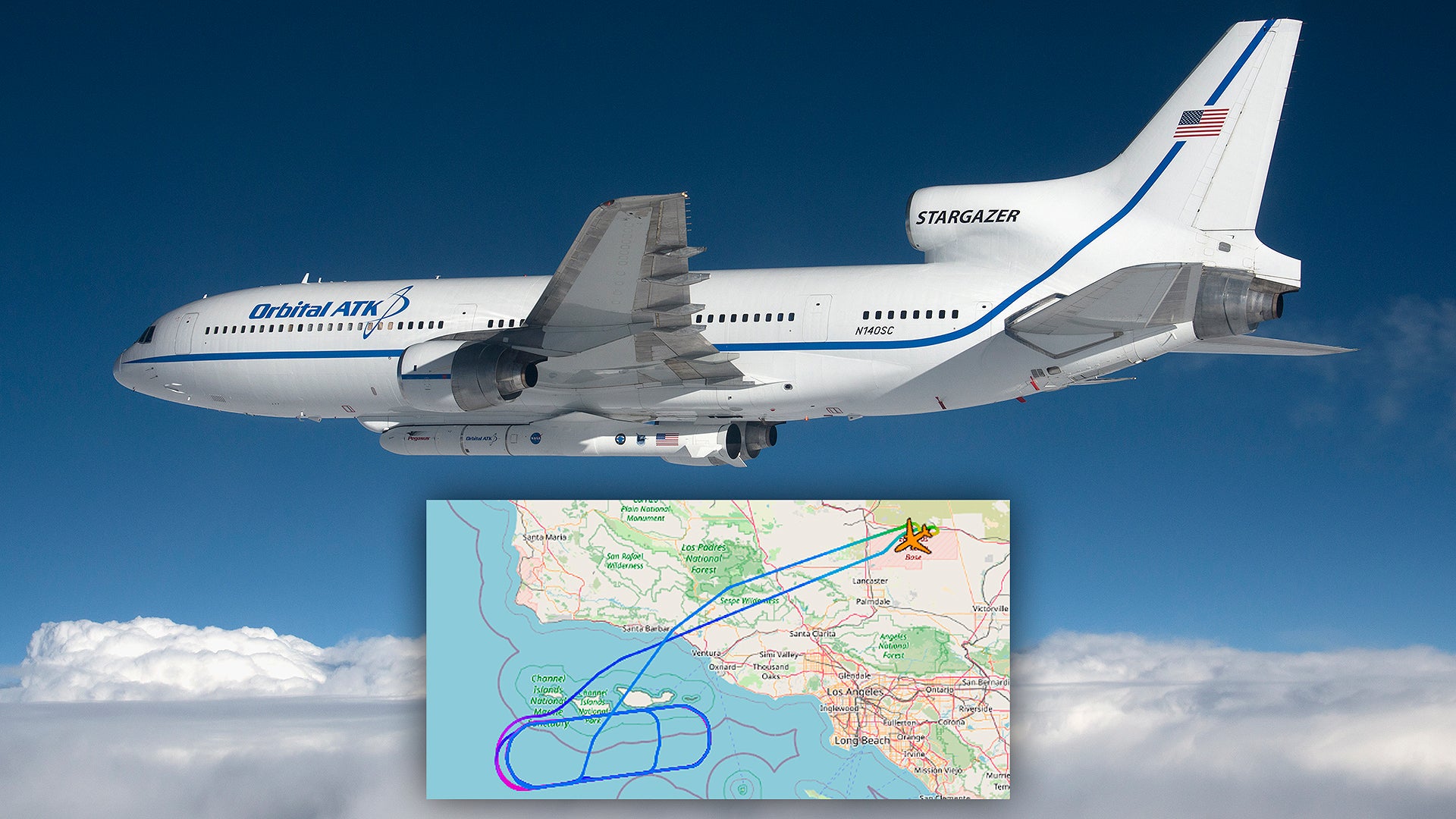Northrop Grumman’s Stargazer conducted a curious flight from Edwards Air Force Base in California, out past the Channel Islands off the state’s coast and into the Pacific Ocean, and back yesterday. The aircraft, the only Lockheed L-1011 Tristar still flying today, which normally operates from the Mojave Air and Space Port, is best known as the mothership for the Pegasus XL space launch rocket, but has been involved other advanced aerospace testing in the past.
Aerospace photographer Jack Beyer was among the first to notice Stargazer’s so-far-unexplained outing, which began at around 5:00 AM local time and wrapped up some two hours later. After clearing the Channel Islands, the aircraft, which carries the civil registration code N140SC, had entered in a long, elliptical race track orbit and had begun to climb, eventually reaching an altitude of around 40,000 feet while facing out into the Pacific.

That altitude and direction is notable as is matches the release profile of a Pegasus XL rocket. However, as other observers noted, there were no Notices to Airmen (NOTAM) alerting other aircraft and ships down below of a potential launch, as is typically required. In addition, Pegasus XLs are often mated to Stargazer at Vandenberg Air Force Base, which is where the launches are then usually staged from.
A U.S. Navy P-3C Orion maritime patrol plane, with the Bureau Number (BuNo) serial number 162999, was spotted on flight tracking software orbiting nearby where Stargazer was flying and left the area at around the same time, but it is unclear if the two flights were at all related.

It is possible that this was just a routine training flight so that the Stargazer’s crew could practice a launch operation without actually firing a rocket. However, it’s not clear why Northrop Grumman would have staged such a flight out of Edwards, the U.S. Air Force’s premier flight test facility, which is also home to NASA’s Armstrong Flight Research Center, rather than the aircraft’s home base at Mojave.
This is not the aircraft’s first visit to Edwards recently, either, with it conducting flights overland from the base since at least June, according to online flight tracking data. The part of the Pacific Ocean in which its latest flight took place is in an overwater military range complex commonly used for flight tests and missile launches, too. An Air Force B-52 bomber recently conducted a captive carry test flight of the in-development hypersonic AGM-183A Air-Launched Rapid Response Weapon (ARRW) in the same general area.
As already noted, Stargazer itself has also served as a platform to conduct testing of other aerospace vehicles, such as the abortive X-34 experimental air-launched space plane, including captive carry tests that do not involve an actual launch. Going through the full flight profile used for a launch could have been a way to see how the payload vehicle might respond to the stresses of those maneuvers.

The flight does come amid a surge in the development of hypersonic systems, the testing of which Stargazer could be ideally suited to support. Northrop Grumman and Raytheon have been working together on a scramjet-powered hypersonic cruise missile as part of the Defense Advanced Research Projects Agency’s (DARPA) Hypersonic Air-breathing Weapon Concept (HAWC) program. Separately, Northrop Grumman has been testing advanced scramjet technology that could inform its work on HAWC and other hypersonic efforts in cooperation with the Air Force Research Laboratory (AFRL).


Of course, Stargazer wouldn’t necessarily need to be supporting a program involving another Northrop Grumman product. The U.S. Air Force, as well as the U.S. military as a whole, is otherwise in the midst of a slew of other hypersonic developments, many of which will need to be test flown. Generation Orbit’s X-60A experimental hypersonic testbed, which AFRL plans to use to conduct other related research and development work, is also air-launched and will need some form of mothership to carry it aloft.
These kind of test requirements are only likely to grow in the future. Just today, AFRL released a request for information regarding its own experimental scramjet-powered missile effort referred to as the Expendable Hypresonic Multi-Mission Air Breathing Demonstrator and also known as Mayhem.
The new management behind Stratolaunch and its massive Roc mothership aircraft, the largest plane to ever fly to date, said earlier this year that it would refocus on hypersonic testing instead of space launch activities, underscoring the growing demand in this sector. The Roc is designed to perform the same general mission set as Stargazer, but on a much larger scale.
At the same time, the Air Force, as well as the nascent Space Force and NASA, are still very interested in ways to rapidly put payloads into space, using expendable launch systems or reusable space planes. Pegasus XL represents an existing proven technology for this purpose and Stargazer could be helping with the testing of improvements to that system or new, more advanced concepts of this type, also referred to as two-stage-to-orbit.
There are also almost certainly more hypersonic and space access programs underway in the classified realm, too. The early-morning timing of Stargazer’s recent flight from Edwards suggests that there was a desire to keep any payload the plane might have been carrying, out of the public eye.
We have reached out to the Air Force, NASA, and Northrop Grumman to hopefully get more insight into Stargazer’s latest mission. We will be sure to update this story with any new details we receive. Regardless, what is clear is that Stargazer is up to something new with the U.S. Air Force.

Contact the authors: Tyler@thedrive.com and joe@thedrive.com
